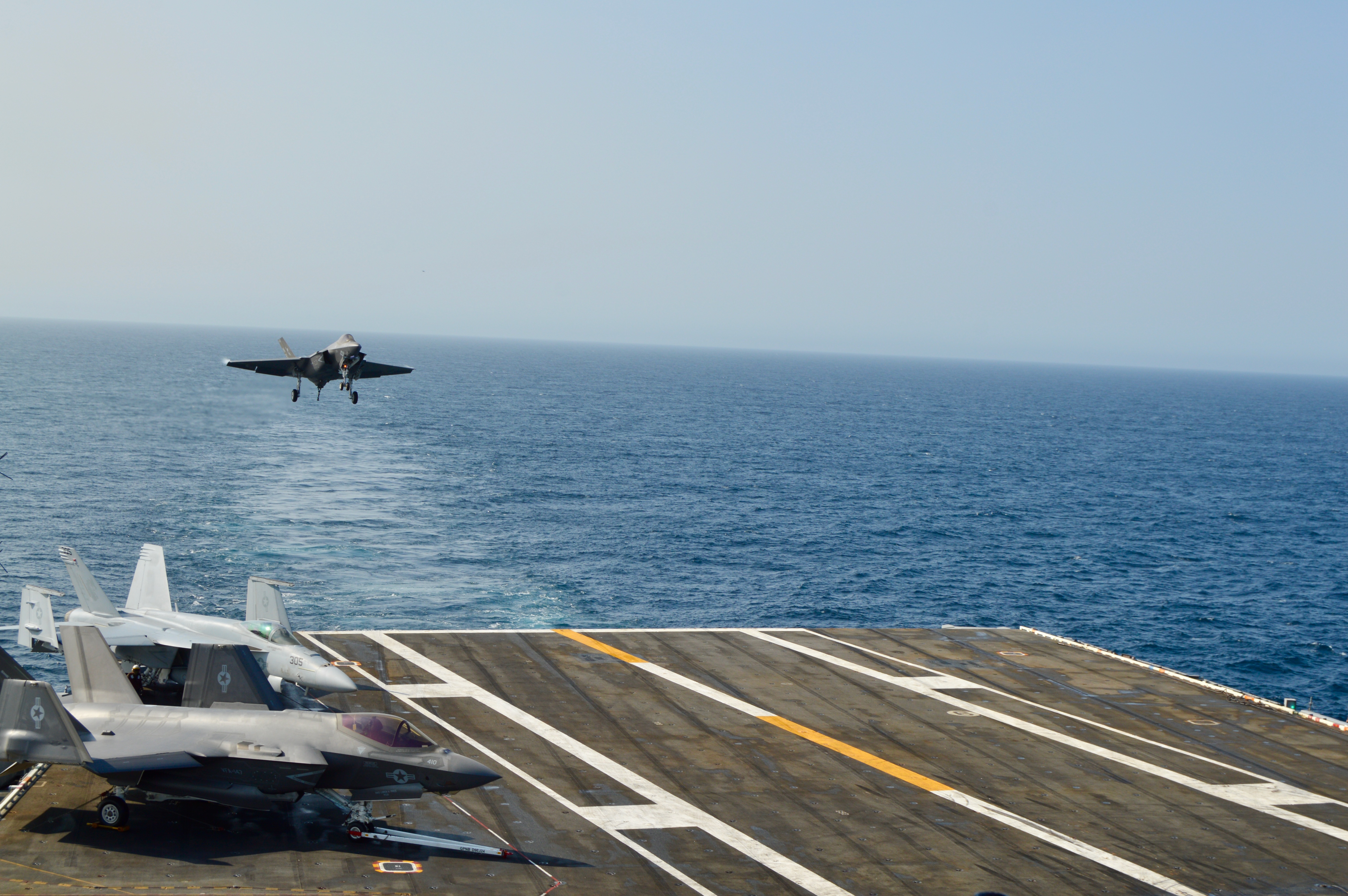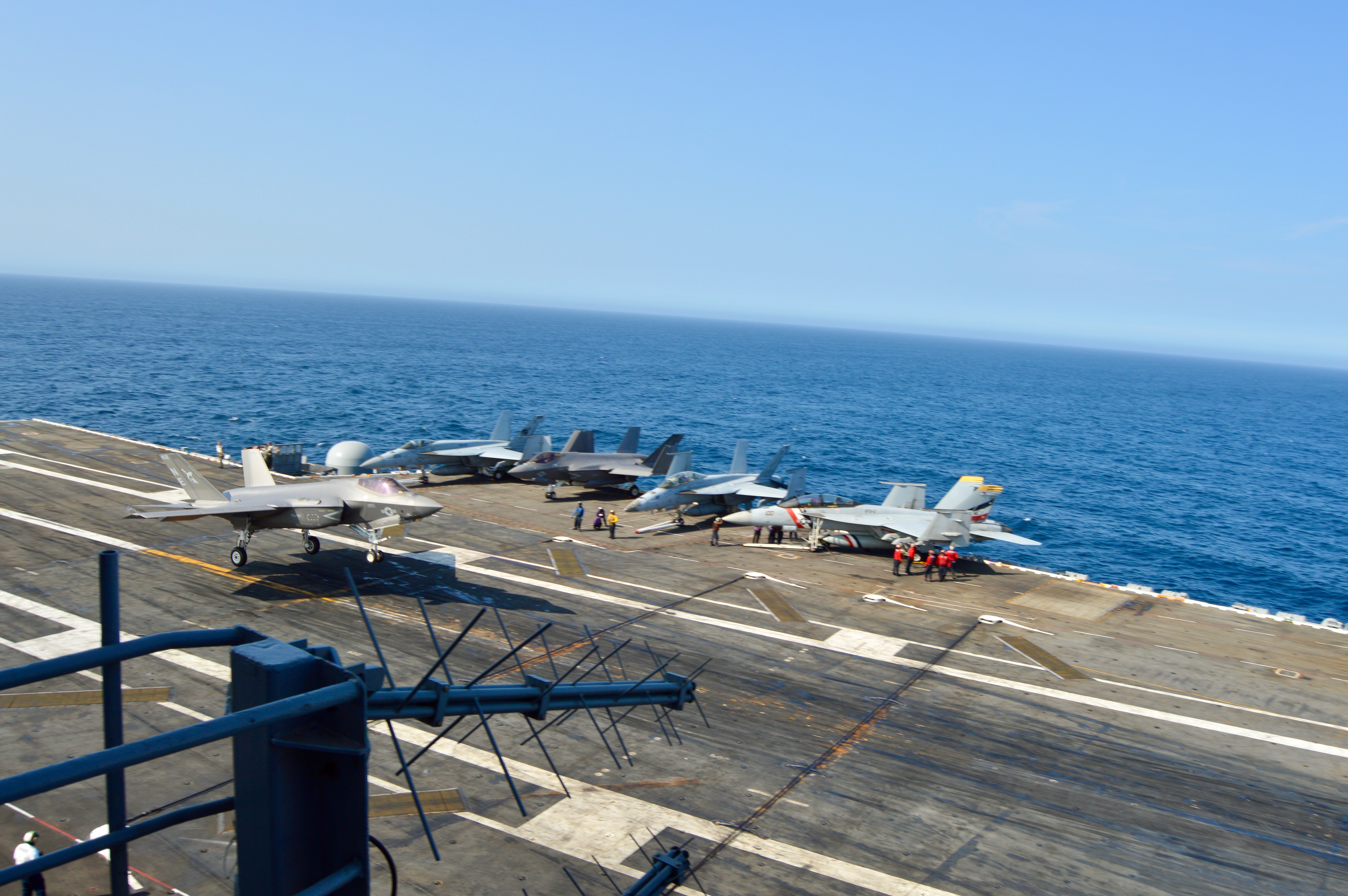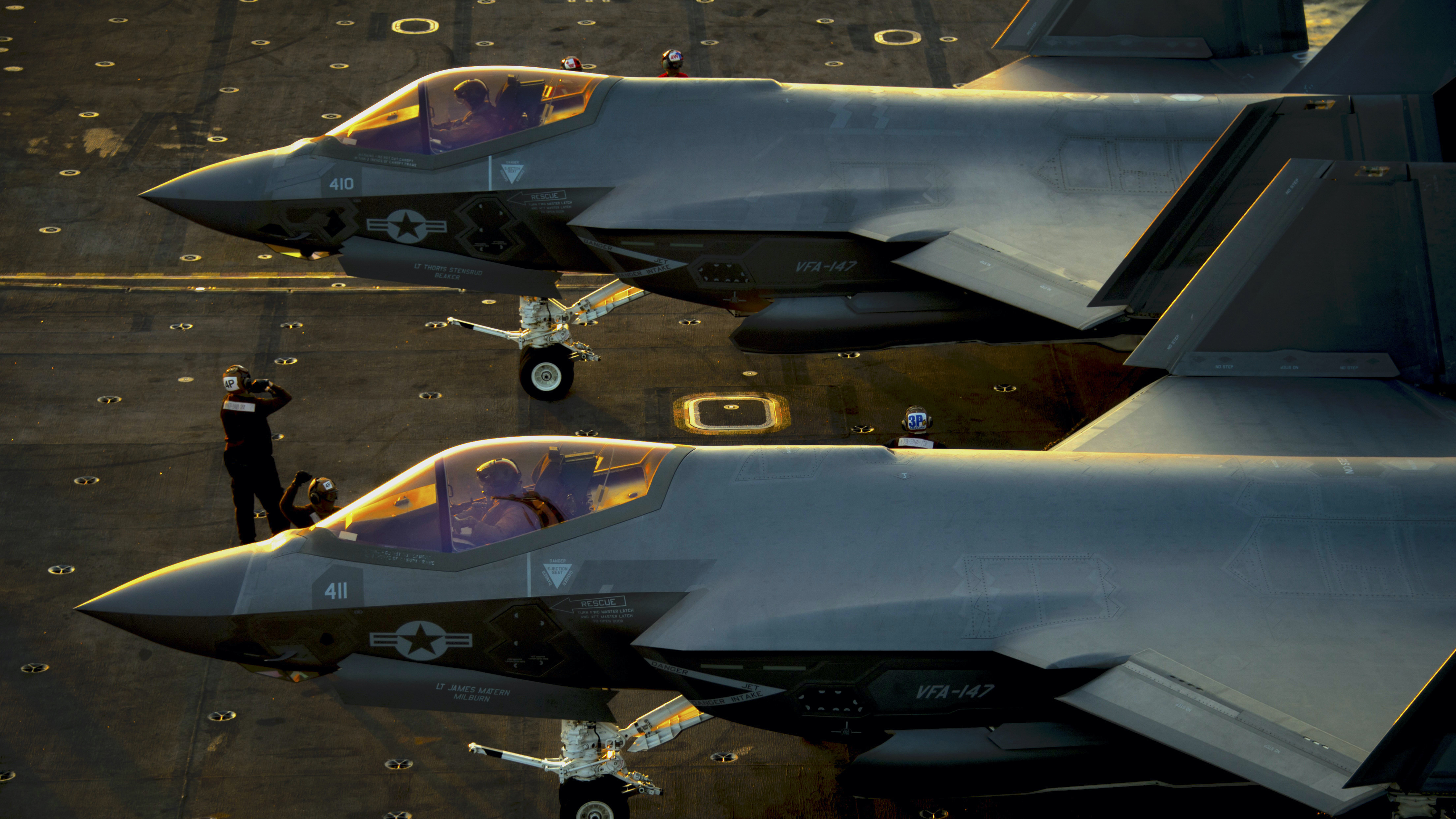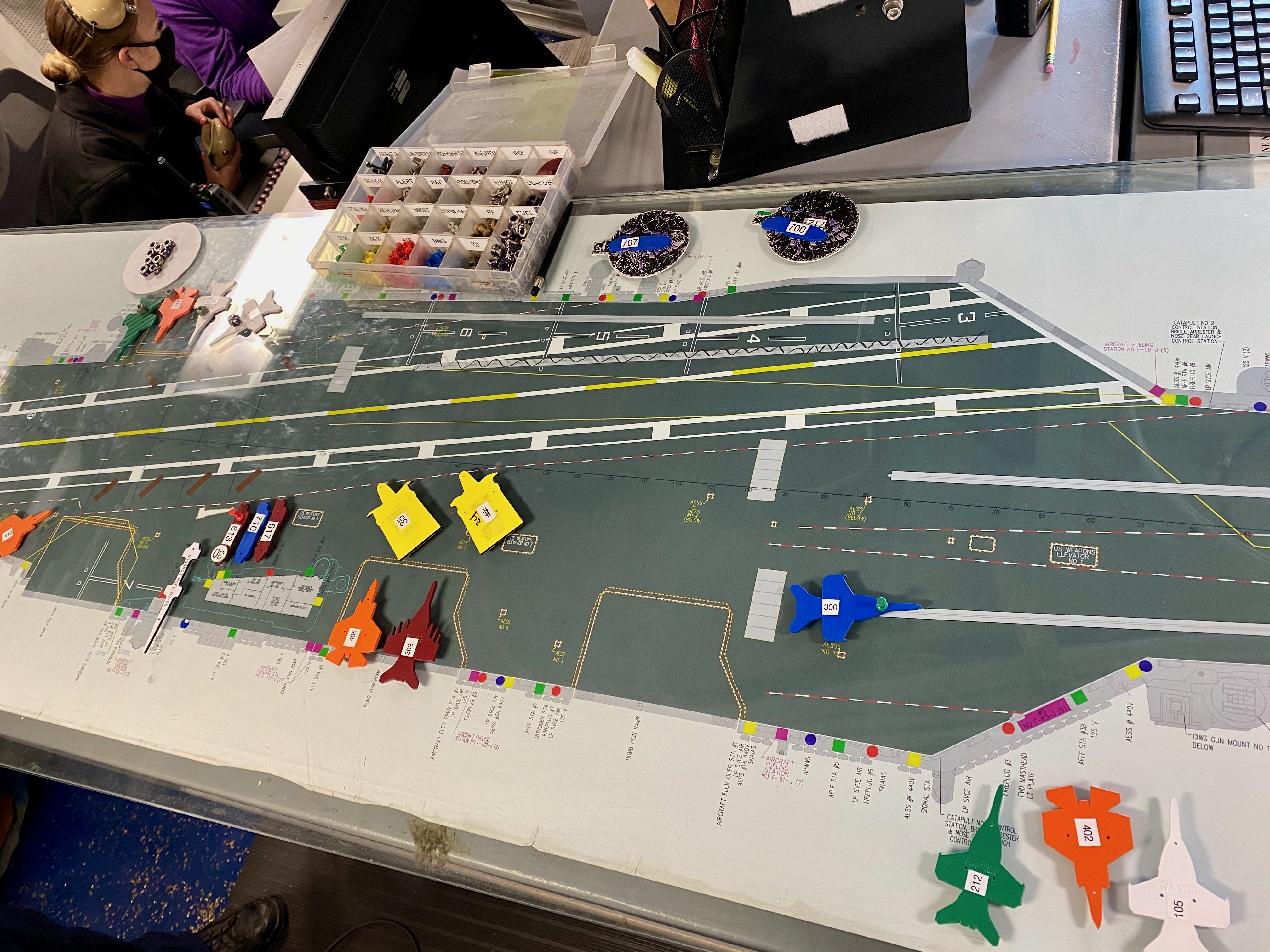
ABOARD AIRCRAFT CARRIER USS CARL VINSON, OFF THE COAST OF CALIFORNIA – Next year, the most advanced carrier air wing in history will sail to the Pacific aboard USS Carl Vinson (CVN-70). Last week, the Carrier Air Wing 2 took the first steps in getting its new F-35C Joint Strike Fighters and CMV-22B Ospreys integrated into the air wing and aboard the carrier.
Vinson went to sea with its air wing for the first time in this deployment cycle, following a lengthy maintenance availability to upgrade the ship to support the Navy’s first deployment of its fifth-generation fighter and a new cargo aircraft to support it.
Though there are still some little details to work out – moving the new F-35C Joint Strike Fighter safely around the deck, practicing with new firefighting equipment designed for the large nacelles on the CMV-22B Osprey – ship and air wing officials say they’re ready to spend this workup cycle figuring out how to leverage the F-35C’s stealth and data-sharing capabilities to make this advanced carrier air wing as lethal as possible.
“Fundamentally, not much has changed: the carrier strike group, we’ve fought integrated for years. And specifically in the air wing, what’s changed are the tools: advanced sensors, stealth technology, access to information. All that’s now being provided to the air wing. And those integrated channels we’ve had, now we’re just using those and passing different information,” Capt. Tommy Locke, the deputy air wing commander, told USNI News during a Sept. 17 visit to the carrier at sea.
To make the most of what the F-35C brings, Locke said the air wing has some other plus-ups: an extra E-2D Advanced Hawkeye was added to the “Black Eagles” of Carrier Airborne Early Warning Squadron (VAW) 113, and two additional EA-18G Growlers were added to the “Gauntlets” of Electronic Attack Squadron (VAQ) 136.
“You put those aircraft together, couple that with our kinetic capacity of the F-18E/F, it’s a pretty powerful combination, able to distribute fifth-generation information, increase lethality of our legacy platforms, but also (increase) the survivability as well,” Locke said.
“Our air wing configuration, again with the F-35C Lightning II as well as the E-2D, EA-18G Growler and the legacy F-18s, it really provides the strike group commander a very effective and efficient way to project power. So offensive in nature, but we also bring a pretty unique capability of gathering real-time over-the-horizon intelligence, information, passing that throughout the strike group to share in that fifth-generation information, and then also kinetic and non-kinetic fires to support carrier strike group defense.”
In conversations with sailors in the carrier strike group, the main focus of this advanced air wing seemed to be the F-35’s ability to sneak undetected into air space the air wing previously couldn’t safely access, scoop up information of all kinds to share with the rest of the carrier strike group, and perhaps take out a target or two to make way for the firepower of the F/A-18E-F Super Hornets coming in behind it.
Locke said specifically the combination of the F-35C and the Growler would control the air space, deny enemy access and leverage the electromagnetic spectrum in a way the air wing never could before.
The Nav conducted its first integrated carrier air wing operations with the F-35C in August 2018 aboard USS Abraham Lincoln (CVN-72), though those operations were focused on the ship being able to launch and recover a combination of F-35s and Super Hornets seamlessly, without having to give special attention to the new fighter and treat it any differently than the other fixed-wing aircraft.
Locke said work has been ongoing at Naval Air Station Lemoore to get the F-35Cs and the Super Hornets used to flying together, but technically the integrated training phase during the deployment workup period hasn’t started yet.

Asked how well integrated the air wing was ahead of the formal workup cycle, Locke said, “we’re good. We’ve got some ways to go to be great. Our next phase for the air wing is, we’re doing an integrated basic phase” where all the fixed-wing planes will come off the carrier and conduct integrated air-to-air operations with various combinations of Super Hornets, Growlers, F-35Cs and Advanced Hawkeyes against “advanced simulated threats.”
Eventually, the whole air wing will go through its advanced training syllabus at Naval Air Station Fallon before coming back to the aircraft carrier to join up with the destroyers and cruiser for full CSG integrated operations.
Asked how the F-35C would change how the air wing collaborates not only with the carrier but also the combatants, Locke said, “It’s all information. It’s the speed of information, how quickly you get it. E-2D plays a critical role, its nodes are connected really well with the surface fleet. It’s feeding information to the airborne fighters. All the fighters have the information they need; if they don’t they can share with each other; and if they don’t, they can get it from the E-2D. So in some cases we don’t need much, but there are also some cases when you may be fighting and you need a lot of information from the surface (ships).”
A detachment of CMV-22B Ospreys from the “Titans” of Fleet Logistics Multi-mission Squadron (VRM) 30 will replace the aging C-2A Greyhound as the carrier onboard delivery (COD) platform, a necessary upgrade because the F-35C has a single large engine that the C-2 cannot carry. Locke said the air wing hasn’t done much work with VRM-30 yet, as the squadron just recently received its first aircraft and is working to quickly get the pilots and maintainers trained up and ready for a deployment likely next year.
“We’re trying to do small events with them to start integrating them into our drumbeat, if you will,” Locke said.
Preparing the Carrier for the New Air Wing

Leaders on Vinson are excited to have the new aircraft onboard and say it’s really not so different from previous air wings, other than the excitement of being the first to deploy with the fifth-generation fighter.
Still, there are some little differences they’re trying to work through now to ensure the jets aren’t damaged and people can operate safely around them.
Vinson Commanding Officer Capt. Matthew Paradise said during the ship tour that new jet blast deflectors with added cooling were installed on the ship during its recent 17-month docking planned incremental availability to address the greater heat coming out of the F-35’s single engine. A new computer system was put in to support the Autonomic Logistics Information System (ALIS) logistics system the F-35 uses, lithium-ion battery storage and charging space was created for the jets’ batteries – the first time a jet has required these large batteries that pose potential fire hazards, but likely not the last time, officials said – and ready rooms and maintenance spaces were upgraded to support the F-35C and CMV-22B. For the Ospreys, new fire wands were installed on the flight deck that can reach high enough to put out an engine fire on the tall nacelles, if needed.
Paradise noted that, while this was the first time CVW-2 with the “Argonauts” of Strike Fighter Squadron (VFA) 147 had embarked on the ship, it wasn’t the first time VFA-147 and its F-35Cs had operated from Vinson. This carrier was used in late 2018 and early 2019 to conduct carrier qualifications, safe-for-flight certification and operational tests, culminating in a Feb. 28, 2019, declaration of initial operational capability. Paradise said his team used lessons learned from that experience, from Lincoln’s operations and from elsewhere in the Navy and industry to inform its early operations with the F-35C now.
“It’s certainly a team effort. Our role is to be able to taxi the aircraft. We have a role in maintaining them as well, we have a pretty big maintenance function here. And so all that, you’re right, requires training. And so formal schools, a lot of on-the-job training. We have sent our sailors to where the JSF are in Lemoore to get hands-on training, and then we don’t go directly to deployment, we are training right now,” he said.
“We’re kind of the crawl, walk, run mentality, we’re going nice and slow, making sure that everybody’s learning the new jet and just getting the band back together really for the first time in the workup cycle.”
Cmdr. Matthew Koop, Vinson’s miniboss, told USNI News that, from the flight deck perspective, F-35C is “the new toy in the room right now, but we treat them like we do everyone else.”
They mostly are towed, launched and recovered the same as a Super Hornet, though he said the catapult crews took some time early on when the jets first flew on to learn the slightly different catapult hookup on the F-35C compared to the F-18s.
“There’s also some fragile control surfaces near the tie-down chains, so some of the tie-down spots, the chains, if they’re done improperly could damage the surfaces of the JSF,” Koop said while speaking to USNI News in the ship’s Primary Flight Control.
“Their squadron personnel understand that right now and are teaching the flight deck crew how to properly do it without damaging the aircraft, which is a little bit different than some of the other aircraft because usually our blue shirts down there will do all the what we call chocks and chains, chaining them down, but now we’re having the squadron personnel do it for this underway and they’re training our guys on how to properly do it.”

Down in Flight Deck Control, Flight Deck Officer Lt. Caleb McDonald and Aircraft Handling Officer Lt. Cmdr. Gilbert Bishop said the F-35C is also mostly being treated as normal already. McDonald said the F-35C is much larger than the F/A-18A-D Hornet is replaced, so there are some spots on the deck that a Hornet could park where the F-35 won’t fit. Bishop said the team did training at Joint Base McGuire-Dix-Lakehurst, N.J., to understand F-35C parking, movement to the catapults for launch and more, to ensure the safety of personnel and the jets. And both said the “Ouija board” still operates just the same, with the F-35Cs in VFA-147 being shaped slightly differently than their Super Hornet counterparts but still being moved around the board and labeled for maintenance, rearming and refueling just the same as any other aircraft type.
Asked if there was anything he needed from VFA-147 to help the squadron maneuver the flight deck properly, Bishop said the F-35 pilots were already following the hand signals well.
“It’s like we already knew each other, pretty much. A nice smooth integration,” he said.
Cmdr. William Gray, the aircraft intermediate maintenance department officer, showed off the lithium-ion battery charging and storage room – among the coolest spaces shown during the ship tour, with chill water and ventilation rerouted during the DPIA to create a cool room for the batteries to charge safely.
“This is the first airplane, naval airplane that’s flown this battery, and these batteries … you can get a really small battery with a lot of energy. They started using lithium-ion in spacecraft and now we’re down in the aircraft, and the advantage of these batteries are they produce a lot of power when you need it. The F-35 has two of them, and actually one of the batteries can support, if you have a propulsion failure the battery can actually support the flight control system of the aircraft, which is pretty awesome, a pretty nice thing to have in the airplane when things are going wrong,” he said.





